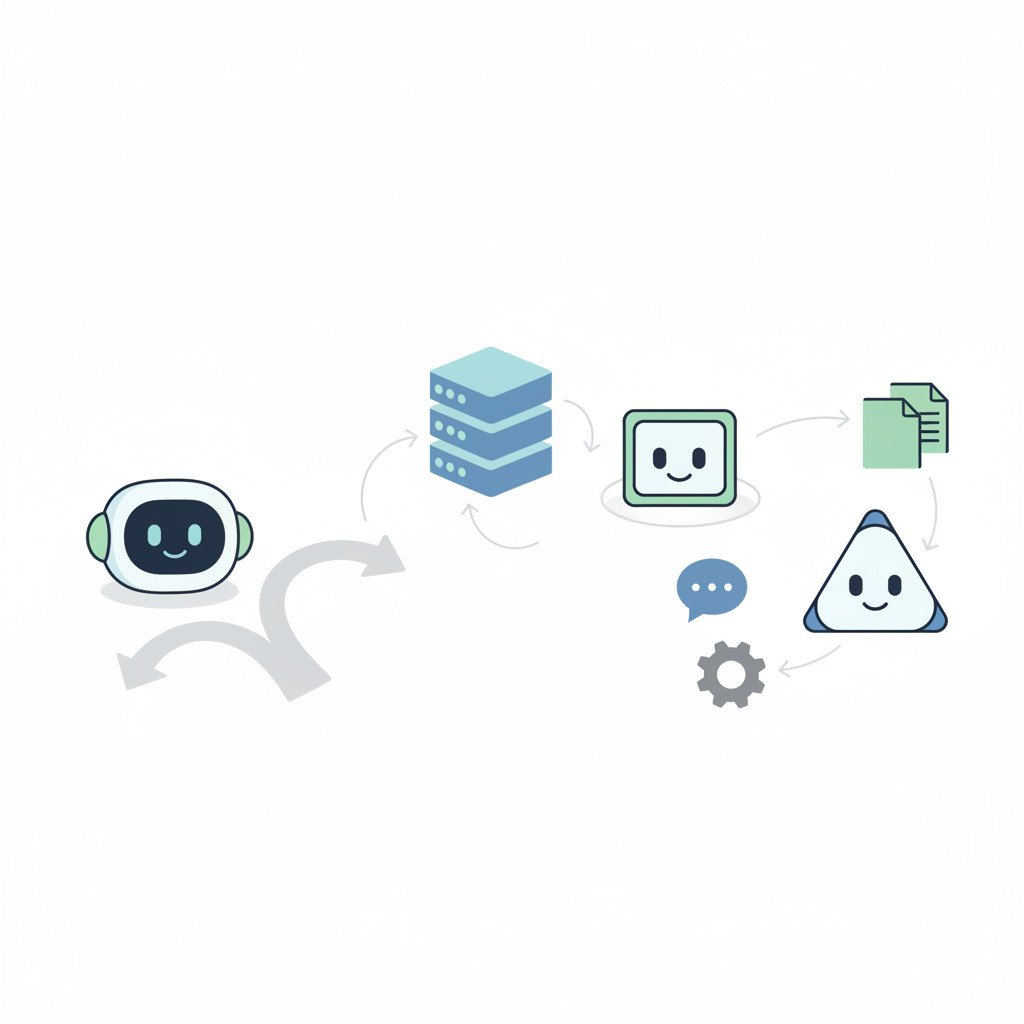Agentic AI: Separating Hype from Practical Automation
Agentic AI describes systems that plan, act, and adapt with minimal human prompts. Because they can self-direct tasks, they promise faster automation and new workflows. However, the gap between vendor hype and enterprise readiness remains wide.
This article explains what agentic AI does, where it helps, and where it risks failure. We focus on practical automation using terms like AI agent factory and orchestration engines. For example, Virtual Authoring Teams and Druid Conductor show factory style deployment. Yet governance, traceability, and data integration must guide pilots to avoid bias and automation debt. Therefore readers will get recommended checkpoints for safe enterprise rollouts.
Readers will learn how to evaluate agentic AI platforms on execution, integration, and compliance. This balanced review covers use cases like contact-centre operations, document processing, and IT service management. Finally, we offer practical steps to pilot agentic AI safely, measure ROI, and maintain human oversight.
agentic AI: concept, autonomy, and real-world differences
Agentic AI refers to systems that plan, take actions, and adapt without continuous human prompts. Because they hold goals and can sequence tasks, they act like autonomous assistants. However, they differ sharply from traditional AI tools that only respond to direct queries.
Key differences include
- Autonomy and initiative. Agentic AI sets subgoals, chooses tools, and follows multi-step plans. For example, an agent can run a data extract, summarise results, and schedule a meeting without prompts.
- Decision-making under uncertainty. Traditional AI suggests options, whereas agentic AI evaluates tradeoffs and picks a course. For instance, an agent may reroute a workflow when an API fails.
- Long-lived state and memory. Agentic systems track context across sessions, so they optimise over time.
- Tool use and orchestration. Agentic AI calls external services and composes workflows, for example integrating CRM and document stores.
- Human oversight and governance needs. Because they self-direct, agents require traceability, audit logs, and guardrails.
In practice, organisations can use agentic AI to automate contact-centre tasks, process documents, or manage IT tickets. For practical guidance on orchestration and safe scaling see this article. Meanwhile, early finance pilots show time reclaiming benefits; read this article. Finally, prepare data readiness to prevent prompt hijacking at this article.

agentic AI applications: practical use cases across industries
Agentic AI moves beyond pilots when it solves end to end tasks at scale. For example, it can run personalised campaigns, route leads, and close repetitive service tickets autonomously. As a result, teams gain time and focus on higher value work.
Key use cases include
- Marketing automation. An agent monitors campaign performance, runs rapid experiments, and iterates creatives. It reallocates budget to top performers, and it triggers personalised outreach when prospects show intent. This visual scenario looks like a dashboard that updates itself and sends ready-to-use content to teams.
- Sales and revenue operations. Agents qualify leads, schedule demos, and enrich CRM records. Consequently sales reps receive warm, prioritised opportunities. In one vivid example, an agent detects a high-value account signal and orchestrates outreach across email and calendar.
- Customer service and contact centres. Agents handle tier one tickets, summarise cases, and escalate complex items. Meanwhile humans review only flagged edge cases. Therefore response times fall and customer satisfaction rises.
- Document processing and compliance. Agents extract data from contracts, check clauses, and file audit trails. Thus legal teams find risks faster and reduce manual review time.
- IT service management and operations. Agents diagnose incidents, run remediation playbooks, and update status pages. As a result, mean time to repair falls and engineers focus on architecture.
Each application needs governance, traceability, and data integration. However organisations should start with controlled pilots to measure ROI. Finally, because agents can act independently, guardrails must remain central.
Comparative table: agentic AI tools and features
| Tool | Key features | Industry fit | Strengths | Notes and benefits |
|---|---|---|---|---|
| Druid AI | Virtual Authoring Teams, Druid Conductor orchestration, Agentic Marketplace | Banking, healthcare, insurance, education, contact centres | Factory model for rapid agent build, strong orchestration, enterprise templates | Enables faster agent deployment, integrates human oversight and data sources |
| OpenAI GPTs | Large language models, extensible plugins, conversational agents | Cross industry, marketing, sales, customer service | Natural language depth, easy prototyping, broad ecosystem | Good for prototyping; however requires orchestration for safe autonomy |
| Anthropic Claude Projects | Safety-focused LLMs, task planning primitives | Finance, healthcare, regulated sectors | Strong safety guardrails, principled responses | Suit high compliance needs, yet needs integration work |
| Google Vertex AI Agents | Integrated tooling, Google cloud data connectors, multimodal agents | Enterprise cloud customers, analytics-heavy firms | Tight cloud integration, scalable infra | Works well where Google stack is core |
| Microsoft Copilot Studio | Copilot building blocks, Office and Azure integration | Enterprise productivity, sales, legal | Deep app integration, enterprise security controls | Accelerates desk-level automation and knowledge work |
| Cognigy | Conversational automation, omnichannel bots, workflow connectors | Contact centres, customer service | Conversational depth, channel reach | Strong in voice and chat automation |
| Kore.ai | Dialogue management, low-code builder, enterprise connectors | Telecom, utilities, customer support | Low-code for business users, strong CRM connectors | Enables citizen developer use cases |
| Amelia | Conversational AI, process orchestration, cognitive agents | Insurance, banking, HR | Mature virtual agent capabilities, proven deployments | Focuses on enterprise-scale conversational workflows |
Conclusion: practical takeaways on agentic AI and next steps
Agentic AI can automate multi-step work and reduce repetitive tasks. However governance, traceability, and data integration must lead adoption. Therefore organisations should treat agentic AI as a systems project, not a point tool.
We found clear strengths and real risks. For example, AI agent factories accelerate agent production but they can create automation debt if unchecked. As a result, pilots should include ROI metrics, audit logs, and human review gates. Meanwhile, controlled contexts like contact-centre operations and document processing make sensible starting points.
EMP0 (Employee Number Zero, LLC) helps businesses convert experiments into production. They build AI powered growth systems that multiply revenue while keeping data and controls inside clients infrastructure. EMP0 deploys solutions under customer control and integrates orchestration, monitoring, and compliance checks. This approach reduces vendor lock in and preserves enterprise security.
If you want to explore agentic AI safely, consider practical pilots with strong governance. Finally, learn more about EMP0 and its services at EMP0 Services and read case studies at EMP0 Case Studies. Follow updates on Twitter at Medium, or see workflow builders at n8n workflow builders.
Frequently Asked Questions (FAQs)
What is agentic AI?
Agentic AI describes systems that set goals, plan steps, and act with minimal human prompts. Because they can sequence tasks and call tools, they behave like autonomous assistants. They also keep state and learn from outcomes over time.
How does agentic AI differ from traditional AI?
Traditional AI typically responds to single queries or classifies data. By contrast, agentic AI makes decisions across steps and adapts when conditions change. Therefore it requires orchestration, memory, and tool integration.
Which business problems work best for agentic AI?
Start with controlled, repeatable workflows. Good examples include contact-centre triage, document processing, marketing experiment loops, and IT remediation playbooks. These cases benefit from automation, speed, and reduced manual handoffs.
What risks should organisations expect and how can they govern them?
Risks include bias, compliance breaches, and automation debt. To manage them, implement audit logs, human review gates, and clear rollback procedures. Also ensure data readiness and continuous monitoring.
How should teams pilot agentic AI safely?
Begin with a small, measurable pilot in a low risk area. Define success metrics and keep humans in the loop. Finally, iterate quickly, add guardrails, and scale only after proving ROI and compliance.

